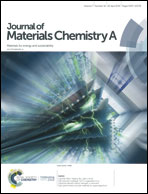An effective polysulfide trapping polar interlayer for high rate Li–S batteries†
Abstract
A microporous and polymeric C3N4 framework (CNF), when exploited as an interlayer and as a cathode host in Li–S batteries, demonstrates significantly improved electrochemical behavior with a special relevance to high rate applications up to 5C. A CNF obtained through a template free synthesis approach and activated with KOH is endowed with a high specific surface area of 1000 m2 g−1, a desirable nitrogen content (13%) to ensure polarity and a microporous architecture, required to increase the accommodation capability of discharge products. The difference in electronegativity between C and N in CNFs combats in a major way the shuttling of lithium polysulfides (LIPSs) and ensures the realization of increased LIPS binding sites due to the presence of pyridinic nitrogen. Furthermore, a CNF driven change in the molecular configuration of adsorbed LIPSs leads to the uniform distribution and sequestration of discharge products. Similarly, micropores and the polymeric nature of CNFs facilitate the effective confinement of LIPSs and ably accommodate the volume changes (through the formation of Li2S upon discharge) respectively, especially when a microporous CNF interlayer is involved in the Li–S assembly. In particular, a CNF with 60 wt% sulfur loading, otherwise represented as CNFS-60, when exploited as a cathode in combination with the deployment of a CNF interlayer exhibits appreciable capacity values of 500 and 400 mA h g−1 at 3 and 5C respectively. Furthermore, the combination of the CNF interlayer and cathode demonstrates a steady state discharge capacity of 437 mA h g−1 at 1C rate up to 300 cycles, without any significant capacity loss. The involvement of chemical interaction of the CNF with lithium polysulfides is demonstrated using density functional theory calculations. Hence, the effective trapping and the subsequent localization of migrating LIPSs arising from the strong chemical interaction of the CNF with soluble LIPSs and the advantages of high concentration of accessible pyridinic nitrogen sites to the LIPS adsorption in improving the electrochemical behavior of the Li–S system could be understood. This new CNF based interlayer provides a promising approach and ample scope for its implementation in futuristic Li–S batteries.



 Please wait while we load your content...
Please wait while we load your content...